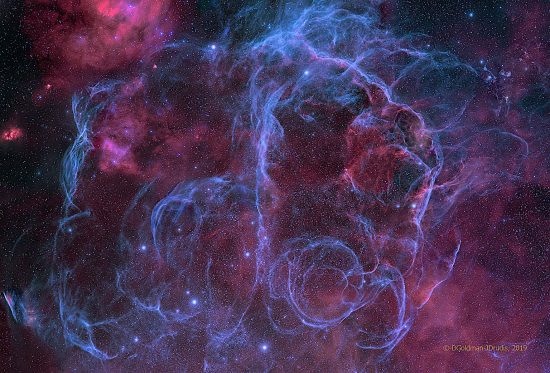
March 25, 2020
Supernova remnants are not governed by gravity.
Many Pictures of the Day point-out that astronomers find connections between supernova remnants (SR) and the rest of the galaxy. Bipolar SRs, in particular, arrange themselves non-randomly.
Most SRs are double-lobed, meaning that twin emissions erupt from each side of their axes, giving them the appearance of two funnels connected with a central star. It was assumed that those formations are haphazard, with no order or connections to each other. However, when compared with the Milky Way’s magnetic field, the lobes match its orientation.
Since magnetic fields are more easily detected than electric fields, astronomers think that those magnetic fields are “primordial” fragments left over from the Big Bang. When no electric influences are seen, there is a tendency to to ignore the fact that moving charges constitute an electric current that generates magnetic fields. Without the initial electrical input, there can be no magnetic fields. When more charged particles accelerate in the same direction, that field gets stronger.
Charged particles move in circuits, so the effects from electric circuits should be considered. Consensus astronomers see isolated celestial objects in space, so they are puzzled when energetic events or objects seem to exceed gravity’s abilities. Electric Universe theory emphasizes connectivity with an electrically active network of Birkeland current filaments, which can exert influences exceeding 39 orders of magnitude greater than gravity.
Those filaments expand and explode, throwing off plasma that approaches relativistic velocities. The bipolar outflow can emit X-rays and sometimes gamma-rays. Plasma science and not gas kinetics, gravity, or particle physics is the governing principle behind SRs.
A previous Picture of the Day about Galaxy M51, otherwise known as the Whirlpool Galaxy, discussed its magnetic field, along with a cloud of high-speed electrons, extending more than 40,000 light years away (as astronomers measure distance) from its center of mass. The magnetic field and cosmic rays (electrons) appear to be denser in the galaxy’s spiral arms, an observation that supports Electric Universe theory. Consensus science has difficulty explaining galactic magnetic fields (and cosmic ray electrons) because no electrical entities exist to create that magnetism.
The same confusion holds true for supernova remnants and other nebular formations. No electromagnetism, no electric fields, and no motor-generator effects are included in their calculations, and those calculations are not able to predict the observed magnetic fields.
Stephen Smith
The Thunderbolts Picture of the Day is generously supported by the Mainwaring Archive Foundation.












